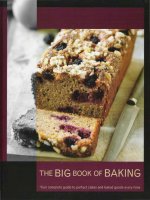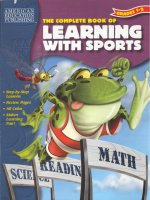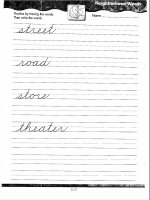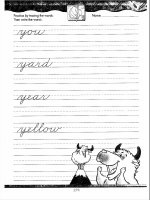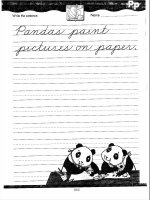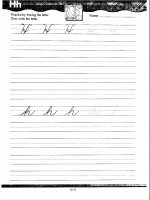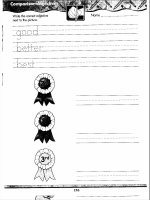the big book of classroom poems
Bạn đang xem bản rút gọn của tài liệu. Xem và tải ngay bản đầy đủ của tài liệu tại đây (6.23 MB, 176 trang )
BY K ATHLEEN M. HOLLENBECK
NEW YORK
•
TORONTO
•
LONDON
•
AUCKLAND
•
SYDNEY
MEXICO CITY
•
NEW DELHI
•
HONG KONG
•
BUENOS AIRES
The Big Book of Classroom Poems © Kathleen M. Hollenbeck, Published by Scholastic Teaching Resources
Scholastic Inc. grants teachers permission to photocopy the poetry pages and activity page from this book for classroom
use. No other part of this publication may be reproduced in whole or in part, or stored in a retrieval system, or transmitted
in any form or by any means, electronic, mechanical, photocopying, recording, or otherwise, without permission of the
publisher. For information regarding permission, write to Scholastic Inc., 557 Broadway, New York, NY 10012-3999.
Front cover and interior design by Kathy Massaro
Cover art by Katherine Lucas
Interior illustrations by Dawn Apperly, Mike Gordon, James Graham Hale, Mark Hicks, and Bari Weissman
ISBN 0-439-43826-8
Copyright © 2004 by Kathleen M. Hollenbeck
Published by Scholastic Inc.
All rights reserved.
Printed in the U.S.A.
1 2 3 4 5 6 7 8 9 10 40 11 10 09 08 07 06 05 04
To a place of darkness
few may understand,
comes a firm assurance
and a gentle hand.
Guided by such efforts,
ground so kindly tilled
reaps the joyous harvest
of a dream fulfilled.
o Sarah Morry,
Dr. Robert Legare,
Reverend Michael Menna,
Dr. Dana Chofay,
and Dr. Maureen Chung
with gratitude for your wisdom,
commitment, and compassion.
Thank you.
T
%
%
The Big Book of Classroom Poems © Kathleen M. Hollenbeck, Published by Scholastic Teaching Resources
Introduction 6 Why Use Poetry? 6 Ways to Use Poems in the Classroom 7
School Days • 13
School Supplies 13
Deep in My Desk 13
Classroom Helper 14
The Substitute Teacher 15
Fire Drill 16
Open House 17
On the Move 17
Hoping for a Snow Day 18
Indoor Recess 18
The Hall 19
Seating Trouble 2
0
My Lunch Box 21
Blowing a Bubble 21
What Makes a Winner? 22
Checking My Work 23
Language Arts • 24
Alphabet Poems 24
Word Family Poems 37
Five Vowels 51
Person, Place, or Thing? 52
Verbs 52
Adjectives 52
Pronoun Play 53
Seaside Homonyms 53
Just Alike
(Synonyms) 54
Outside Antonyms 54
More Than One (Plurals) 55
Whose Is It? (Possessives) 56
Outdoor Bedtime (Compound Words) 56
Understanding Idioms 57
A Question of Rhyme (Writing a Poem) 58
Paper Talk (Writing a Letter) 59
Filling in the Blanks (Writing a Story) 6
0
Story Trail (Reading) 61
Math • 62
New Crayons (Counting) 62
Window Math (Counting) 63
The Candy Store Lady (Counting) 64
Number Families (Addition
&
Subtraction) 65
Schoolroom Shapes 65
Same or Different? (Attributes) 66
Who’s Next? (Patterns) 67
Sneakers in Line
(Patterns) 68
How Many? (Estimation) 69
Time Trouble 7
0
What Time Is It? 7
0
How Tall? (Measuring Height) 71
Pet Pounds (Measuring Weight) 71
How Long? (Measuring Length) 72
Overflow (Measuring Volume) 72
Thermometer (Measuring Temperature) 73
Times Tables (Multiplication) 74
Cupcake Math (Division) 75
The Arts • 76
The Color Club 76
Star 77
Free to Draw 77
A Sticky Situation 78
My Painting 79
Pictures of Life 79
Collage 8
0
Clay 8
0
Musical Muse 81
A World on Stage 82
C
o
n
t
e
n
t
s
The Big Book of Classroom Poems © Kathleen M. Hollenbeck, Published by Scholastic Teaching Resources
Winter Sleep 1
0
4
At the Zoo 1
0
5
Where Do I Live? 1
0
6
City Creatures 1
0
8
What Animal Am I? 1
0
9
Peek Into the Pond 11
0
Frog 111
Creepy Crawlies
Busy Bee 112
Bzzzz! 112
Ladybug 112
The Song of a House Fly 113
Why, Fly? 113
Night Visitor 114
Fireflies 114
Fuzzy Fellow 115
Monarch Migration 115
Ants 116
Intersection Insects 116
Spider 117
Earthworm 117
Plants & Seeds
The Seed 118
Sidewalk Sprout 119
Garden Flower 12
0
Inside a Tree 121
Tree Roots 122
My Apple Tree 123
Pine Tree 124
The Oldest Tree 125
The Seasons: Autumn
Autumn Wind 126
Autumn in the Park 127
Harvest Rainbow 127
Pumpkin Possibilities 128
Apple Treats 128
Hayride 129
Scarecrow 129
Science • 83
Health & Safety
Messy Hands 83
The Magic Bar of Soap 84
My Loose Tooth 85
Crocodile Smile 86
Bike Safety Rule Riddles 87
My Body 88
My Five Senses 89
Weather
City Sky 9
0
My Place in the Clouds 91
Fog 91
Summer Storm 92
Rain Beat 93
Raindrops 93
Gray Days 94
Hail 95
Water and Ice 95
Energy & Conservation
Electricity 96
Save a Little Water 97
One Won’t Make a Difference 97
Recycle 98
Second Chance 98
Sun, Moon & Beyond
The Sun 99
The Moon 99
Moon Glow 1
00
Stars Sparkle 1
00
Planet Panic 1
0
1
Animals & Habitats
Animal Babies 1
0
2
Animals of the Air 1
0
3
Animals of the Land 1
0
3
Animals of the Sea 1
0
3
Animal Homes 1
0
4
The Big Book of Classroom Poems © Kathleen M. Hollenbeck, Published by Scholastic Teaching Resources
The Seasons: Winter
Snowflakes 13
0
Tasting Snowflakes 13
0
Winter Haiku 131
Frost 132
My Bed in Winter 132
Mittens, Hat, or Boots 133
Snow Sculptures 133
Winter Storm 134
Winter Wind 134
The Seasons: Spring
Signs of Spring 135
The Coming of Spring 135
Tiny Buds 136
First Flowers 136
Grass 137
Picnic in the Park 137
The Seasons: Summer
Summer Day 138
Feet Feelings 139
Summer Sports 139
Beach Day 14
0
Shells 141
Sand Sculptures 141
Moonlight, Summer Night 142
Social Studies • 143
Feelings & Fears
All About Us 143
My Teddy 144
Scary Things 144
A Friend for Me 145
Caring & Cooperation
Two Words 146
Listening Ears 147
Being Kind 148
Showing Respect 149
What Does It Mean to Be Responsible? 15
0
Sharing 15
0
Cooperation 151
Peace 151
Neighborhood & Community
Who Makes Up a Family? 152
Home 152
Getting Around 153
Subway 154
Where Will I Go? 155
Who Am I? 156
United States 157
What Symbol Am I? 158
Where in the World Am I? 159
Holidays & Special Days
Chinese New Year 16
0
Martin Luther King, Jr. 161
Groundhog Day 162
Valentine’s Day 163
The 1
00
th Day 164
Celebrate!
(Black History Month) 165
Mr. Lincoln
(Presidents
’
Day) 166
History’s Women 167
April Fool’s Day 168
It’s Earth Day! 169
A Time to Remember
(Memorial Day) 17
0
Hurrah for the Fourth of July! 171
Halloween Party 172
Spooky Things 172
Election Day 173
Veterans Day 173
Thankful 174
Lights of Winter Darkness
(Winter Holidays) 175
Birthdays by Number 176
Candles 176
The Big Book of Classroom Poems © Kathleen M. Hollenbeck, Published by Scholastic Teaching Resources
W
hen I was eight years old, I wrote a poem for a third-grade language
assignment. While not an amazing piece of literature, that poem became
important to me. Its creation marked the exact moment my passion for
words came alive and proved the spark that ignited a lifelong devotion to writing.
Today in your classroom, you have the opportunity to spark in your students feelings
of enthusiasm, excitement, comfort, and compassion. You can foster a love of words,
guide students in recognizing meter and rhyme, strengthen their reading skills, and
broaden their awareness of the world around them . . . all through the use of poetry.
Inside this book, you’ll find more than 240 fun, easy-to-read poems, each linked with
a learning element from the primary curriculum and designed to appeal to students in
kindergarten through grade 3. Often written from a child’s point of view, the poems
entertain and inspire, probe and present, ask and apply. As you share the poems with
students, you’ll tickle your tongues and weave your way through a maze of verse that
touches on hundreds of subjects familiar and important to young minds. You’ll flit with
a housefly, absorb the essence of the four seasons, and meet word families up close.
Poems dealing with key topics in language arts, math, science, social studies, character
development, and the arts fill these pages. Open this book and step in to discover that
poetry in line with the needs and interests of its audience can expand the experience of
language, and any topic under the sun—or even around it!
Why Use Poetry?
{
Poetry Tells It Like It Is. Poems cover every topic imaginable, in depth or on the
surface. Meant to explore and explain, poems can make difficult subjects easy to
understand and the obvious even more so.
{
Poems Come in All Shapes and Sizes—Literally! From haiku to ballad, they
vary in length and depth. They can be three lines or thirty-three, providing
abundant detail or just a bit.
{
Poetry Builds Reading Fluency. Poetry offers endless opportunities to practice
key aspects of fluency such as phrasing, intonation, punctuation, and vocabulary.
Many poems carry a lyrical, sometimes predictable rhythm that practically rolls
off the tongue, making them fun to read aloud, pleasant to hear, and easy to
follow along.
{
There’s a Poem for Everyone. While not every poem will appeal to every reader,
somewhere, somehow, every reader who seeks will most certainly find at least one
that grabs his attention or tickles her funny bone.
6
Introduction
The Big Book of Classroom Poems © Kathleen M. Hollenbeck, Published by Scholastic Teaching Resources
{
Poetry Waltzes With Words. Within the walls of a poem exist opportunities
to examine the use of phonics, parts of speech, alliteration, metaphor,
patterning, meter, placement, rhyme, and a host of other lingual elements.
{
Poetry Strengthens Communication Skills. As students share poetry, they
can’t help but bolster skills in reading, listening, and speaking.
Ways to Use Poems in the Classroom
Poetry, by its very nature, begs to be shared, and there are dozens of ways to do that
in the classroom. Look over the suggestions below and choose the ones that will
appeal most to you and your students.
{
Read Aloud Often. Read poems aloud, and have students read to you. You
can gauge their comprehension by observing how they recite. Do they use
appropriate expression? Is their timing on track? Do they pick up on the meter
and potential rhyme scheme of the poem?
{
Enjoy Rather Than Analyze. In the primary grades, cultivating a love of
literature and poetry holds more importance than focusing on mechanics. As
much as possible, help students notice and appreciate poetry for the way it
sounds, the images it depicts, and the emotion it conveys.
{
Where’s the Rhyme? Explore the use of different rhyme schemes, as in
“How Many?” (page 69), “Hail” (page 95), “My Apple Tree” (page 123), and
“Mittens, Hat, or Boots” (page 133). Discuss the idea that rhyming poems do
not always employ the same rhyme scheme; the rhyme can come at the end
of a line, in the middle of a sentence, or any place where the poet feels it best
serves the sound and the course of the poem.
7
Teachers reach for poetry,
and lessons come alive,
illuminating history
and how to count to five,
describing common feelings
or sharing silly tales,
identifying elephants,
exploring ants and whales.
No matter what the topic,
how stately or absurd,
when teachers reach for poetry,
they know they will be heard.
The Big Book of Classroom Poems © Kathleen M. Hollenbeck, Published by Scholastic Teaching Resources
{
Plan a Pocket Chart. As a teacher of young children, you know well that
poetry and pocket charts go hand in hand. Many of the poems in this book are
perfect for pocket charts. Write each line of a selected poem on a tagboard
strip, and place the lines in order in your pocket chart. Then:
◆
Match Missing Portions of the Poem. Cover the animal baby names in the
poem “Animal Babies” (page 102). Write the name of each animal baby
on its own strip of tagboard, and have students match the name of each
baby to its mother.
◆
Reach for Riddles. On small strips of tagboard, write or draw the answers
to riddles such as those in “Peek Into the Pond” (page 110). Invite
students to place each animal or insect with the riddle that describes it.
◆
Make a Rebus.Turn any poem into a rebus by replacing—or asking
students to replace—specific words of the poem with pictures. The poem
“Outside Antonyms” (page 54) offers nearly a dozen rebus opportunities.
{
Up With Acrostics! Invite students to model a poem or two after the language
poems “Person, Place, or Thing?” and “Verbs” (page 52), or “Ants” (page 116),
which are acrostics. Students can create acrostics (poems in which the first
letter of each line combine to spell a word vertically) using virtually any noun
in the English language as the subject, including their own names.
{
Try Tongue Twisters. Many of the poems in the alphabet section of this book
can be used as tongue twisters. Invite students to select words from the poems—
or any words they like—to make their own tongue twisters for classmates to
recite. Looking for one to get you started? Try “The Letter F” (page 26).
{
Sound It Out! Inspire students to write poems
describing the sounds they hear in real life. The
hissssss of a whistling teapot and the whhhooo of
a cold winter wind bring winter to mind.
{
Make a Mobile. Use a poem as the model for a
mobile your students can make and hang in the
classroom. Choose a poem that describes a
variety of items, such as “Planet Panic” (page
101), which names the nine planets and tells
fictitious tales about them. Have students cut
and color tagboard circles to represent the
planets and the sun. Using string, suspend these
at different lengths from a clothes hanger. (Hang
the planets in order according to their distance
from the sun.) On each planet, have students
glue a conversation bubble that tells what the
planet might have said to express the way it felt
in the poem.
8
The Big Book of Classroom Poems © Kathleen M. Hollenbeck, Published by Scholastic Teaching Resources
{
Try Haiku and Tanka. Haiku offers children a way to write without trying
to rhyme or arrange words on the page. In haiku, writers determine word
choice and placement according to the number of syllables per line. Haiku
usually involves reference to nature and contains the syllable pattern 5-7-5
(5 in the first line, 7 in the second line, 5 in the last). Explore this poetry
form with “The Sun” and “The Moon” (page 99) and “Winter in the Park”
and “Smooth” (page 131). Tanka, similar to haiku but longer in length, often
follows a similar syllable pattern: 5-7-5-7-7. Examples of tanka include
“Raindrops” (page 93), “Recycle” (page 98), and “Winter Storm” (page 134).
{
Create a Poetry Wreath.
Cut 4-inch shapes of any kind
(stars, circles, pumpkins, and
so on) from sturdy
construction paper. Cut the
center circle from a 9-inch
paper plate, and use the
outside as the base of a poetry
wreath. Have students copy
the lines or verses of a poem
onto different shapes. Then
help them glue or staple the
shapes onto the wreath,
placing them in order
(clockwise) to duplicate the
original poem.
{
Put Poems on Display. Write the verses of a poem on any shape that fits
with your classroom motif, and post it on a wall at students’ eye level. For
example, you might write verses on a string of railroad cars, a group of
ducklings following their mother, or a bunch of balloons in the sky.
{
Use Poems for Movement. “At the Zoo” (page 105) calls for creative
movement, with instructions alongside the poem. Ask students to act out
other poems as well, dramatizing poems such as “Seating Trouble” (page 20)
and “Checking My Work” (page 23).
{
Bring Imagery to Life. The poem “Scarecrow” (page 129) describes a
simple, homemade scarecrow in a field. Provide craft sticks, fabric swatches,
glue, and yarn, and direct students to make the scarecrow they envisioned as
they listened to the poem. You might also want to provide chalk for them to
recreate the swirls and designs described in “Frost” (page 132) or clay to
recreate some of the animals named in the poems on page 103.
{
Paint Poetry Placemats. Reproduce a poem and ask students to illustrate
it, using colorful markers or crayons. Laminate each student’s page to make a
placemat for snack time.
9
The Big Book of Classroom Poems © Kathleen M. Hollenbeck, Published by Scholastic Teaching Resources
{
Make a Poetry Cube. Photocopy the reproducible “Make a
Poetry Cube” (page 12) and distribute it to students. Have
them write each line (or verse, depending on the length of
the selection) on one square of the cube, beginning at
square number 1. Then fold up the cube as directed, tape
in place, and turn it to recite the poem.
{
Post a Poem-of-the-Day. Choose a poem a day to write
on the chalkboard near the day’s assignments. Incorporate
the poem into your morning routine, just as you may
already do with the hot lunch count and today’s weather.
{
Work With Word Families. Write the word family
poems (pages 37–50) on chart paper. Invite students to circle the words from
each family, replace them with other words from the family wherever possible,
and make word family mini-books, bookmarks, and scrapbooks.
{
Head Out on a Word Hunt! Build word recognition and emphasize parts of
speech by setting student detectives on a hunt for specific words in the poems.
In “Person, Place, or Thing,” “Verbs,” and “Adjectives” (page 52), have
students use highlighters to mark the nouns, verbs, or adjectives they find. In
other poems, send them searching for words to add to a thematic word wall
(words that describe heroes, have to do with planting, name vehicles, and so
on).
{
Change the Words. Dozens of the poems offer chances to replace nouns,
verbs, and adjectives with synonyms or simply other words of the same part of
speech. For example, in the poem “Verbs” (page 52), the words eat, rescue, and
be can be easily replaced by words such as share, cuddle, and hug. In “Just
Alike” (page 54), challenge students to replace one of the synonyms in each
line with a word that means the same thing.
{
Home in on Homonyms and Antonyms. “Seaside Homonyms” (page 53)
contains four homonym pairs (pale /pail, to/two, our/hour, and sea/see), but
has additional words that have a homonym partner not mentioned. (Examples
include we/wee, there/their, not /knot, for/four, and in/inn.) Challenge students
to find both the homonym pairs and the would-be homonyms. In “Outside
Antonyms” (page 54), have them replace the object of each antonym with a
different object that fits with the adjective. For example, instead of The sun is
hot. The snow is cold, students might write The stove is hot. The fridge is cold.
{
Move Into Math. Learning-rich opportunities abound using the math poems
in this book. Some suggestions follow:
◆
Extend the counting activity in math poems such as “New Crayons”
(page 62) and “Window Math” (page 63) by having students count up
the crayons and windows in your classroom.
10
12
Make
a Poetry
Cube
1
2
3
1
5
6
4
3
2
The Big Book of Classroom Poems
Scholastic Teaching Resources
The Big Book of Classroom Poems © Kathleen M. Hollenbeck, Published by Scholastic Teaching Resources
◆
Substitute the math sums and differences in “Number Families” (page
65) to review newly learned math facts. (The poem has been set up to
allow for substitution.)
◆
Look for additional real-life shapes to go with “Schoolroom Shapes”
(page 65), real-life student bodies to replicate the pattern in “Who’s
Next?” (page 67), and students’ own footwear to duplicate that described
in “Sneakers in Line” (page 68). At the end of “Sneakers in Line,” readers
are challenged to figure out how many pairs of each kind of sneaker the
class had if they had 20 pairs in all. To complete the pattern, the class
would need to put down two more pairs of sneakers that closed with
Velcro, six more pairs with laces, and three more pairs of slip-ons.
◆
To accompany “Overflow” (page 72), fill two different-sized glasses with
the same amount of water and note how the same volume of water can
appear different. Also, add the same amount of water to two identical
glasses and then add several rocks or ice cubes to one. What happens?
◆
For a genuine reenactment of “Cupcake Math” (page 75), bake cupcakes
and let the class brainstorm ways to divide them so that each child will
get an equal serving that includes some portion of frosting. (Cut the
cupcakes in half!)
{
Shape a Subject. Examine the shape poems “Blowing a Bubble” (page 21),
and “Water and Ice” (page 95). Have students write their own shape poems,
emphasizing the idea that they can be rhyming or non-rhyming.
{
Tell It on a Time Line. Help your students make a time line to record the
events of a day at the beach, as described in the poem “Beach Day” (page 140).
11
“-an Riddles” (page 39): pan, fan, man
“-ash Riddles” (page 4
0
): sash, ash, mash, cash
“-aw Riddles” (page 42): jaw, straw, paw, law
“-est Riddles” (page 44): rest, best, test, vest
“-ill Riddles” (page 46): hill, ill, will, still
“-ore Riddles” (page 49): chore, store, bore, snore
“Bike Safety Rule Riddles” (page 87): helmet, street, light, one
“What Animal Am I?” (page 1
0
9): hen, pig, rooster, horse, cow, sheep
“Peek Into the Pond” (page 11
0
): dragonfly, frog, bug, fish, snail
“Where Will I Go?” (page 155)
restaurant; shoe store; library or
bookstore; candy store;
supermarket; laundromat; train
station, bus station or airport; pet
store
“Who Am I?” (page 156) baker,
pilot, bus driver or taxi driver,
dentist, mail carrier, teacher,
veterinarian, hairdresser or barber
“What Symbol Am I?” (page
158): American flag, bald eagle,
Statue of Liberty, Uncle Sam
Riddle Answer Keys
The Big Book of Classroom Poems © Kathleen M. Hollenbeck, Published by Scholastic Teaching Resources
12
Make
a Poetry
Cube
1
2
3
1
5
6
4
3
2
The Big Book of Classroom Poems © Kathleen M. Hollenbeck, Published by Scholastic Teaching Resources
13
S CHOOL DAYS
Deep in My Desk
Deep in my desk,
under papers and pencils
and tissues and folders and glue,
wedged between homework
and crumpled art projects
and maybe an old snack or two,
somewhere among all the
markers and crayons
and library books overdue,
there is a math book I need right away.
Yes! There’s the edge of it! Phew!
School Supplies
I filled my supply box with markers and tape,
pencils, erasers, and glue,
scissors, a ruler, erasable pens.
Now I can’t close it. Can you?
The Big Book of Classroom Poems © Kathleen M. Hollenbeck, Published by Scholastic Teaching Resources
14
S CHOOL DAYS
Classroom Helper
I want to help.
What can I do?
Erase the board
and wash it, too?
Clap erasers?
Sweep the floor?
Pass out straws?
Hold the door?
Put the recess
balls away?
Lead the class at
Pledge today?
I see my name.
What job is mine?
Hurrah!
I get to lead the line!
The Big Book of Classroom Poems © Kathleen M. Hollenbeck, Published by Scholastic Teaching Resources
15
S CHOOL DAYS
The Substitute Teacher
When I got to school today,
my teacher wasn’t there.
Someone else was at her desk
and sitting in her chair.
She didn’t have my teacher’s smile
or hands
or hair
or voice.
She didn’t ask if she could stay.
I didn’t have a choice.
Her smile was warm and friendly.
She told us all her name.
She taught us math and phonics.
We played a spelling game.
She read a funny chapter book
and had us read some, too.
She did just about everything
our own teacher would do.
I learned a lot at school today.
I had a lot of fun.
If my teacher’s out again,
I hope we get this one!
The Big Book of Classroom Poems © Kathleen M. Hollenbeck, Published by Scholastic Teaching Resources
16
Fire Drill
Quietly we sat,
concentrating well,
adding and subtracting.
THEN WE HEARD A BELL!
It was like no other,
loud and long and shrill.
“Line up!” said our teacher.
“IT’S A FIRE DRILL!
Leave your books and pencils.
Stand up right away.
Don’t take coats or backpacks.
EVERYTHING MUST STAY.”
In a line, we hurried,
walking as a class,
straight across the pavement
OVER TO THE GRASS.
Every class stood out there.
All was strangely still.
There we were, a school on hold
FOR A FIRE DRILL.
S CHOOL DAYS
The Big Book of Classroom Poems © Kathleen M. Hollenbeck, Published by Scholastic Teaching Resources
17
Open House
Welcome to our classroom!
Come in! Sit down and stay.
Learn what it is we’re learning.
See how we spend our day.
On the Move
My pencil’s looking dull again.
My throat feels awfully dry.
I have to use the bathroom.
Is there something in my eye?
Imagine all the work I’d do
if I stayed in my seat.
Yet somehow, I keep finding ways
to get up on my feet.
S CHOOL DAYS
The Big Book of Classroom Poems © Kathleen M. Hollenbeck, Published by Scholastic Teaching Resources
18
Indoor Recess
It’s raining and we can’t go out for recess.
Inside games will have to do today.
I-Spy? Bingo? Seven-Up?
Checkers? Puzzles? Hide-the-Pup?
What games do you really like to play?
Hoping for a Snow Day
Snowflakes falling
through the night,
comforter of icy white,
thick enough for snowsuit play,
but not for schools to close today.
Standing at the bus stop—
WAIT.
Maybe school’s an hour late?
Then a sound we sadly know. . .
school bus tires on the snow.
S CHOOL DAYS
The Big Book of Classroom Poems © Kathleen M. Hollenbeck, Published by Scholastic Teaching Resources
19
The Hall
I need to use the bathroom
but it isn’t lunch or snack.
I take the bathroom hall pass
and I say I’ll hurry back.
I step into the hallway,
close the door, and look around.
No one else is out here.
There is not a single sound.
It’s really kind of special
being out here on my own.
The hall looks so much longer
when you’re in it all alone.
It’s calm and still and peaceful,
and I feel a little free
just being in the hallway
without someone watching me.
S CHOOL DAYS
The Big Book of Classroom Poems © Kathleen M. Hollenbeck, Published by Scholastic Teaching Resources
20
S CHOOL DAYS
Seating Trouble
I really liked the place I sat
near Juan and Bill and Nate.
We always talked and laughed a lot,
and it was really great.
My teacher said we talked too much
and warned us to be still.
We didn’t listen very well,
so one day, she moved Bill.
We tried our best to do our work
and to participate.
Then came the paper airplane fleet.
That morning, she moved Nate.
Juan and I were good as gold
until one fateful day.
Who would have thought a book could fly?
She dragged my desk away.
Here I sit, alone up front,
and now from 8 to 2,
I only pay attention
for there’s nothing else to do.
The Big Book of Classroom Poems © Kathleen M. Hollenbeck, Published by Scholastic Teaching Resources
21
S
t
i
c
k
y
,
s
w
e
e
t
,
a
n
d
s
o
f
t
.
F
l
a
t
a
n
d
t
h
i
n
a
n
d
r
e
a
d
y
.
S
l
o
w
l
y
,
g
e
n
t
l
y
f
i
l
l
s
w
i
t
h
a
i
r
.
B
i
g
g
e
r
.
.
.
b
i
g
g
e
r
.
.
.
P
O
P
!
t
l
y
B
l
o
w
i
n
g
a
B
u
b
b
l
e
My Lunch Box
My lunch box sits
upon the shelf.
I look with longing eyes.
It sits there like
a treasure box
that holds a great surprise.
The lunch bell rings.
I race across
and grab my box and then
I open it. . .
excitement fades. . .
it’s tuna fish again.
S CHOOL DAYS
The Big Book of Classroom Poems © Kathleen M. Hollenbeck, Published by Scholastic Teaching Resources
22
7
3
9
2
4
8
10
6
1
5
S CHOOL DAYS
What Makes a Winner?
Ten math problems on the test.
I try to do them fast.
It looks like Jen’s ahead of me.
I don’t want to be last.
I do the first five quickly,
and then I start to guess.
I’m not sure what I’m doing now.
My paper is a mess.
I rush through numbers nine and ten
and hand my paper in.
Forgot my name. I lose five points,
but I am first. I win!
Or did I ?
Today, I find I got three wrong,
skipped one, and failed the test.
Why did I try to be the first?
I wish I’d done my best.
The Big Book of Classroom Poems © Kathleen M. Hollenbeck, Published by Scholastic Teaching Resources
23
S CHOOL DAYS
Checking My Work
Before I hand my paper in,
I check it out to see
if I’ve followed all the rules
my teacher’s asked of me.
Did I sign my name on top?
Is my handwriting neat?
Did I fill in all the answers?
Are my sentences complete?
Did I check my answers to
be sure I didn’t guess?
I can hand my paper in
if all of these are “Yes.”
The Big Book of Classroom Poems © Kathleen M. Hollenbeck, Published by Scholastic Teaching Resources
24
L ANGUAGE ARTS
3
The Alphabet
The Letter
Baseball, banjo, bed, and better,
these words share the same first letter.
Beetle, bathtub. do you see?
Each word starts with letter B.
Ball, banana, box, and back,
colors such as brown and black,
basket, bumblebee, and birds,
B begins each of these words.
The Letter
A is for acorn
and sweet apple pie,
attic and angel and
arrows that fly.
A sounds can be long
as in ate, ape, and aim,
or short as in Annie,
which is someone’s name.
The Big Book of Classroom Poems © Kathleen M. Hollenbeck, Published by Scholastic Teaching Resources
25
The Letter
D is for dancer and doughnut and dew,
daisy and dandelion, daffodil, too.
Doorbell and duckling and donkey and day;
each one begins in the very same way.
D can put dozens of words in your head,
whether in daylight or darkness you tread.
Daddy and daughter and dove you will see
when out finding words that begin with a D.
The Letter
Cabin, cactus, comb, and cake
show one sound that C can make.
Camel, cup, and candy bar
share the same first sound as car.
Citrus, circus, and city
use the softer side of C.
In fact, when C is paired with I,
the soft sound is the one to try.
L ANGUAGE ARTS
3
The Alphabet
The Big Book of Classroom Poems © Kathleen M. Hollenbeck, Published by Scholastic Teaching Resources

